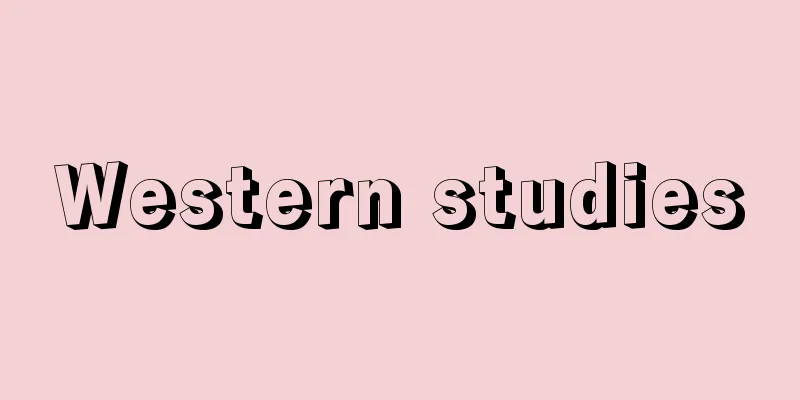Western studies

|
A general term for Western studies that were introduced and studied in Japan during the late Edo period. Interest in Western studies, which included studies in Russian, French, German, and English, as well as Dutch studies, appeared in the early 18th century under Arai Hakuseki and Tokugawa Yoshimune, and some physicians in particular began to pay attention to Dutch medicine. In the late 18th century, the publication of Kaitai Shinsho (New Book of Anatomy) led to a growing trend to learn Dutch, and Dutch studies became popular after Otsuki Gentaku and Inamura Sanpaku wrote introductory books and dictionaries. Dutch studies began with the introduction of medicine, then expanded to natural science in general, and Dutch studies schools appeared, with Dutch scholars cooperating with each other in their activities. In the early 19th century, the shogunate established the Bansho Waku Goyo (Office of Reconciliation of Foreign Books), and while it employed Dutch scholars and absorbed their knowledge, it limited its scope to practical studies and suppressed and controlled political criticism (such as Hayashi Shihei, Siebold, and Bansha no Goku). As the domestic and international situation became increasingly tense at the end of the Edo period, control was strengthened, and Dutch studies shifted its focus to naval defense and military reform, including military arts and gunnery. Some feudal lords in various domains had protected Dutch studies since the Tanuma era, and they adopted it in their domain schools, aiming to promote industry and strengthen the military. The study of Russian language began at the end of the 18th century (Daikokuya Kodayu), but the scope of study expanded around the time of the opening of the country, and English studies in particular developed through English. The Shogunate's Kaiseisho also moved away from an emphasis on natural sciences, and economics, law, history, philosophy, and other subjects were translated and studied, forming the basis for the absorption of new knowledge in the Meiji period. Source: Obunsha Japanese History Dictionary, Third Edition About Obunsha Japanese History Dictionary, Third Edition |
|
江戸後期の日本で紹介・研究された西洋学術の総称。蘭学のほかロシア語・フランス語・ドイツ語・英語による学問を加える 西洋学術への関心は18世紀初め新井白石・徳川吉宗に現れ,特に医師の中にオランダ医学に注目する者が現れた。18世紀後半,『解体新書』の訳出からオランダ語修得の気運が高まり,大槻玄沢・稲村三伯らが入門書・辞典を著してから普及した。医学紹介に始まり,ついで自然科学一般に拡大,蘭学塾も現れ,蘭学者は相互に協力しつつ活動した。幕府は19世紀初め蕃書和解御用を新設,蘭学者を登用し知識を吸収する一方,範囲を実用の学に限り,政治批判などは弾圧し統制した(林子平・シーボルト・蛮社の獄など)。幕末の内外情勢緊迫で統制は強化され,蘭学は兵術・砲術など海防・軍制改革に重点が移動した。諸藩でも田沼時代から蘭学を保護する大名があり,藩校にも採用し,殖産興業ついで軍備強化をめざした。ロシア語学習は18世紀末に萌芽があるが(大黒屋光太夫),開国前後から範囲が拡大し,特に英語を介しての英学が発展した。そして幕府の開成所においても,自然科学偏重から脱し,経済・法律・歴史・哲学などが訳出・研究され,明治期の新知識吸収の基礎をなした。 出典 旺文社日本史事典 三訂版旺文社日本史事典 三訂版について 情報 |
<<: Kindergarten Outline - Kindergarten Outline
>>: Silver iodide (silver iodide)
Recommend
Iemon Kataoka
...This is because the meat pigment myoglobin rea...
Turner, John Napier
Born: June 7, 1929, Richmond, Surrey, England [Die...
Shochiku Co., Ltd.
A production and distribution company for movies, ...
Falculea palliata (English spelling) Falculeapalliata
...But little is known about its song and breedin...
Basic deduction - Kisokoujo
A system that excludes some of the taxable items i...
Festive wear - Haregi
〘 noun 〙 Clothes worn in a special place. Bright c...
Nimitz, Chester William
Born February 24, 1885 in Fredericksburg, Texas. [...
Andonmuro
...19th century greenhouses were at the forefront...
Tadatomo Hoida
Year of death: 19 September 1847 (27 October 1847)...
contagium animatum
...If you look closely at the scabies that appear...
Gum guayule (English spelling) gumguayule
…This raw rubber is used as a raw material, and w...
Satellite attack test satellite
...Cosmos 44 was launched for the Meteor series o...
Louis Dembitz Brandeis
A famous American lawyer who worked hard to reali...
Haeju - Kaishu
A town in the Yanhu District of Yuncheng City, so...
Warm points - Onten
A cold spot is a sensory point that senses tempera...









